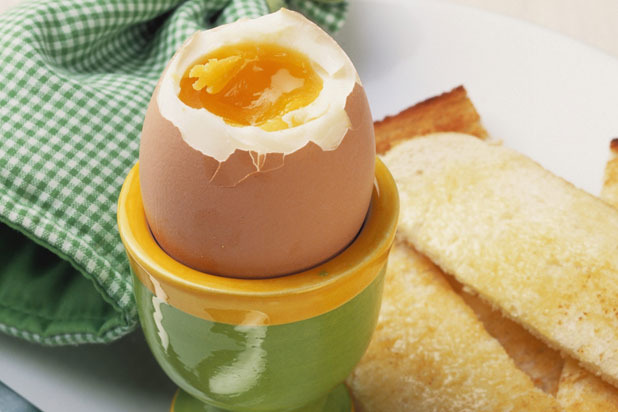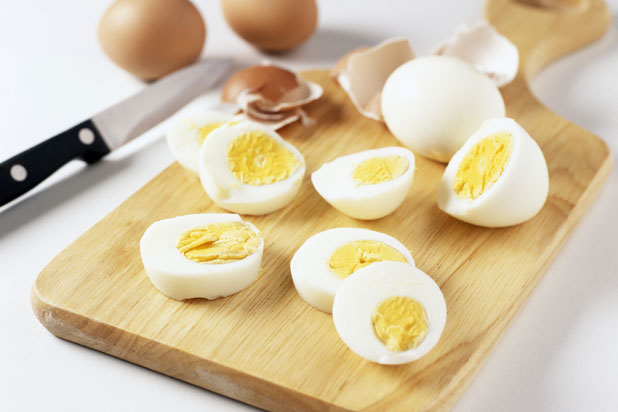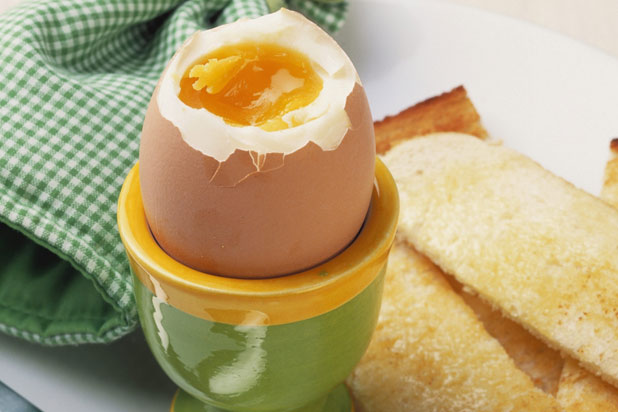Eggs 101: What You Need To Know About Nature's Perfect Food
Eggs are a simple and wonderful ingredient to have in the kitchen, and can be transformed into dishes as diverse as Italian frittatas and Chinese egg foo young. They are also a staple on breakfast and brunch tables in traditional favorites or simply prepared on their own. In their cartons, chicken eggs can be white, brown, speckled, and even blue or green in the case of pullets. Within their shells, eggs are made up of a vitamin and mineral rich orange yolk, and gently cradled in a translucent mass of protein-filled albumen, commonly known now as egg white. Here is everything that you need to know about nature's perfect food, plus a few classic recipes.
Click here to see the Eggs 101 (Slideshow)
Eggs are a popular breakfast dish because of their heart-healthy Omega-3s, protein, minerals, and vitamins. An extra-large egg contains five grams of fat and six grams of protein in addition to vitamins A, B, D, calcium, iron, choline, and anti-oxidants. Eggs have 75 calories each, and if you take out the yolk, egg whites only have 16 calories of pure protein — with no cholesterol or fat. For a while, eggs were believed to increase cholesterol levels and to cause coronary heart disease. Recent studies have now proven otherwise: eating both whites and yolks will not increase blood cholesterol levels unless you have a history of high cholesterol or heart disease. Although eggs do contain cholesterol, nutritionists have proven that consuming it in foods will not significantly impact bodily cholesterol levels.
As soon as an egg is cracked into a hot pan, the egg white quickly changes. The translucent part of the egg whitens as the protein denatures, and the yolk congeals into a creamy consistency. Eat both the yolk and its white together, and you'll have a good dose of protein, essential fats, minerals, and vitamins.
[pullquote:left]
Classic breakfast and brunch dishes include scrambled eggs, poached eggs, fried eggs, omelettes, frittatas, and eggs Benedict. Variations on these basics can pretty much make up an entire breakfast menu. Traditional pairings for eggs include vegetables and animal proteins, like Canadian bacon in eggs Benedict and spinach in its meatless counterpart, eggs Florentine.
To make a classic eggs Benedict, layer a halved English muffin with bacon, add poached eggs on top, and pour Hollandaise sauce over the whole dish. For scrambled eggs, simply whisk eggs together in a bowl, and pour into a buttered pan. Keep breaking up the curdled eggs as they cook, or you'll end up with an omelette.
Cooking an egg in its shell may be the simplest preparation of an egg, but the correct timing is important to know how soft a yolk will turn out. The key to cooking perfect eggs is to closely monitor cooking time, and to make sure that you're starting with cold water for hard-cooked eggs, and with hot water for 3-minute soft-boiled eggs. The hot-water start for soft-boiled eggs is necessary so that the whites are cooked quickly without solidifying the creamy yolks within.
All eggs cooked through in their shells are actually called hard-cooked rather than hard-boiled. While the water should reach a boiling temperature, the eggs themselves should never be cooked in a rolling boil. Boiling eggs like this results in an unappetizing green ring around the yolks and an overly dry texture. The terminology was recently changed because it is a more accurate representation of the cooking method. Naming an egg hard-boiled merely differentiates it from soft-boiled eggs, and does not make reference to how the egg is cooked. A perfect way to use leftover eggs made this way is egg salad.
For a crowd-pleasing party appetizer, serve deviled eggs — a halved hard-cooked egg filled with its yolk whipped in mayonnaise, mustard, vinegar, and served sprinkled with paprika. For a summer picnic, prepare egg salad by dicing hard-cooked eggs and combine with diced celery, sliced green onion, and mayonnaise. For a classic high-tea egg salad sandwich, simply spread egg salad in between two slices of toasted cookie-cutter-shaped white bread.
Egg foo young, which means "lotus egg" in Chinese, incorporates vegetables and chopped meat folded into a well-cooked omelette. Bean sprouts, bamboo shoots, sliced cabbage, mushrooms, springs onions, and water chestnuts are popular add-ins to this Asian omelette topped with brown sauce. Frittatas are the Italian equivalent of a vegetable-filled whipped and fried omelette, much like a quiche, but without the crust.
Poached eggs are a common addition to salads, and a favorite breakfast topping on toast. They're also cooked in water, but need to be tamed into place to make sure they don't spread out while cooking. Adding vinegar to the almost-boiling water helps the egg congeal and maintain a uniform shape.
Coddled eggs can also be made in a pot, with the help of an egg coddler, usually taking the shape of a porcelain cup or ramekin. The egg is broken into a buttered coddler, and then placed in a pot of near-boiling water until it is gently cooked.
For sunny-side up eggs, crack an egg into an oiled non-stick pan. Do not disturb, but watch for doneness. When cooked, the egg whites should set without any transparent parts remaining. The yolk will have formed a thin layer around its edges, but will be runny when cut open with a butter knife. To make over-easy eggs, cook using the same method, but flip midway so that the yolk will have direct contact with the hot pan. For fried eggs, let the eggs cook for longer, and use more oil — the whites will begin to curl up on their edges, and will gently bubble when ready. For scrambled eggs, it's important to whisk the eggs first to get them fluffy and to break up the yolks. Adding two tablespoons of butter to a non-stick pan, and using the right sized pan makes a key difference in keeping scrambled eggs tender and creamy.
Although chicken eggs are the most popular eggs in refrigerators, there are a number of other edible and delicious poultry eggs that vary in flavor and texture. Duck eggs are larger than hen eggs, and have a bigger yolk — for this reason they are often considered to be the creamiest. Goose and pheasant eggs have a gamier taste than chicken eggs, and quail eggs are often used as a topping in gourmet cooking. Ostrich eggs, the largest of the bird egg varieties, are equivalent to 24 normal-sized chicken eggs. These harder-to-find varieties can be found at farmer's markets and specialty food stores and can be scrambled and eaten just like any other egg. The taste of each egg, regardless of the kind, will be greatly affected by the diets of the birds and their living conditions. For this reason, it is important to keep in mind that a cage-free organic egg will have a marked difference in taste from an egg laid by an industrially raised bird.
Eggs should always be stored in the refrigerator to keep them safe to consume. Raw eggs will keep for up to three weeks in the refrigerator, and unpeeled hard-cooked eggs can be stored safely for up to a week. To test an egg's freshness, simply place it in a bowl of water. If it sinks, it is fresh, and if it floats, it is too old to consume. Once cracked, the smell of a spoiled egg is enough of an indication that it's past due. To avoid contaminating a batter or egg dish, always crack individual eggs in a small bowl to check for freshness before incorporating into your dish.
Foolproof Hard-Cooked Eggs Recipe
Try this foolproof recipe for Easter or make it anytime to enjoy hard-cooked eggs.
Click here to see the Foolproof Hard-Cooked Eggs Recipe
Perfect Soft-Boiled Eggs
A simple soft-boiled egg is great on toast for an easy breakfast or snack, any time of day.
Click here to see the Perfect Soft-Boiled Eggs
Click here to see more Egg Recipes
This article was originally published on April 8, 2014.


